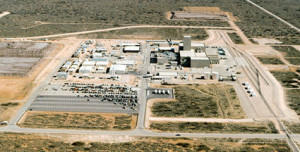Radiation risksNew Mexico demands clarifications, reassurances on WIPP radiation leaks
New Mexico’s environment secretary Ryan Flynn has ordered the Department of Energy (DOE) to explain how it will protect public health and the environment while it investigates a radiation leak at the underground Waste Isolation Pilot Plant (WIPP). The plant has not been in compliance with various permit requirements since the February underground fire and radiation leak, which eventually led to a plant shutdown.

Surface of the underground WIPP facility // Source: ucsb.edu
New Mexico’s environment secretary Ryan Flynn has ordered the Department of Energy (DOE) to explain how it will protect public health and the environment while it investigates a radiation leak at the underground Waste Isolation Pilot Plant (WIPP). The plant has not been in compliance with various permit requirements since the February underground fire and radiation leak, which eventually led to a plant shutdown. The 12 May 2014 administrative order from the New Mexico Environment Department (NMED), which demands that DOE augment its reports to the agency, comes after Flynn publicly expressed his frustration with the lack of transparency at WIPP.
Albuquerque Journal reports that at a meeting in Carlsbad, New Mexico last week, Flynn addressed the audience after WIPP recovery manager, Jim Blankenhorn, declined to answer a reporter’s question about which waste containers were under investigation. Flynn called the refusal “a really good example here of some of the frustration that I’ve had since I was notified about this event.”
“If you have information, you need to disclose that information to the public immediately,” he said, directing his comments to DOE managers and the WIPP contractor. “There is simply no reason to withhold information.”
The administrative order suggests that DOE and the WIPP contractor, Nuclear Waste Partnership (NWP), will not meet NMED’s reporting requirements for monitoring volatile organic compounds, hydrogen, and methane underground, or meet underground inspection schedules. According to the order, DOE and NWP must reveal how they plan to regain compliance on the issues raised. The order also instructs that the weekly reports NMED is entitled to receive be augmented with more detailed reports, which would be due every two weeks.
DOE’s Carlsbad Field Office, in response to questions on the order, said it extends requirements already ordered for the above storage ground to the underground storage. NMED general counsel Jeff Kendall said that though WIPP has improved communication with state environmental officials, with the administrative order, “we know on the record, in an enforceable order, we’re going to get this information regularly. Noncompliance with the order has certain consequences.”.
Blankenhorn confirmed at the Carlsbad meeting that a waste stream from Los Alamos National Laboratory (LANL) is under investigation as a possible contributor to the radiation leak, but he declined to mention the source of another waste stream being investigated. “I’d rather not say the other one at this point because I don’t want to cause a lot of flurry,” he said at the meeting. “So, it’s not that it’s a big secret, but … I don’t want to cause a whole lot of angst and let the cat out of the bag without letting the parties know there is something coming.” Homeland Security News Wire reported last week on a theory that organic absorbents used in some waste containers — and which is also used in cat litter boxes — may have caused a chemical reaction in the LANL waste.
